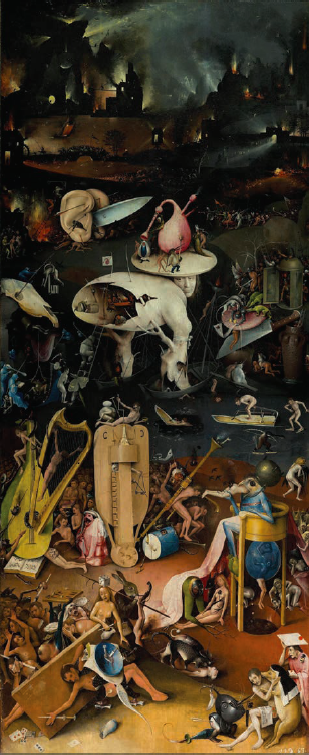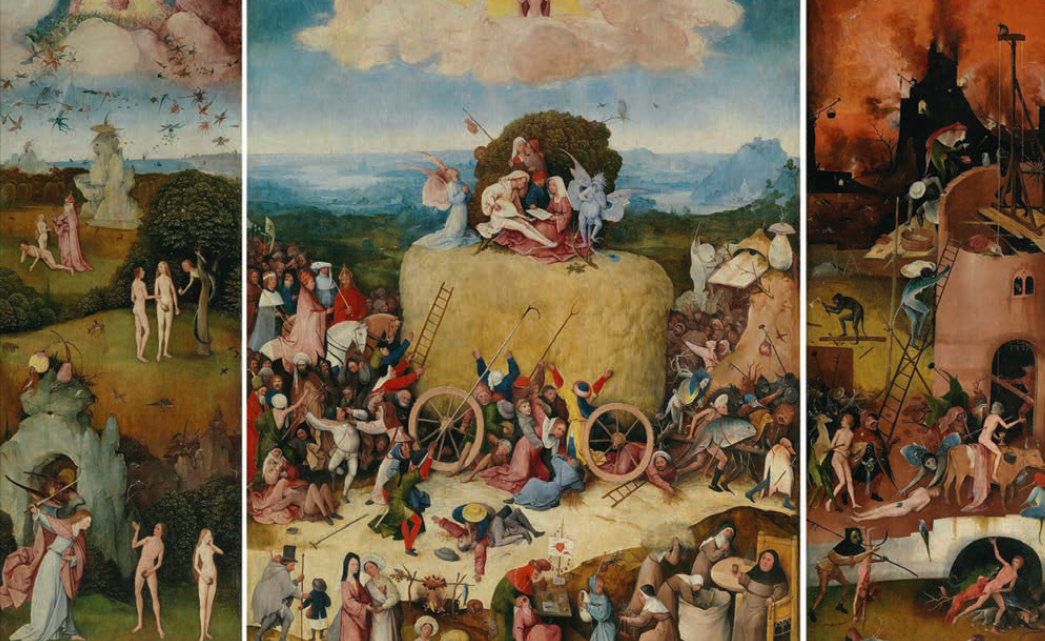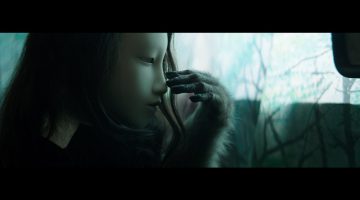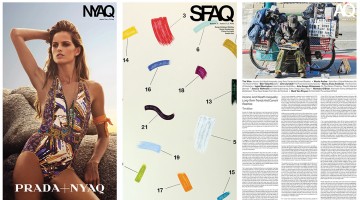Despite decades of scholarly investigation, we still only have a few hard facts about the painter known as Hieronymus Bosch. Even though he signed some of his paintings Jheronimus Bosch, he never affixed a date to them; we can only make educated guesses about when they were painted. His real name was Jerome van Aken, and he lived from about 1450 to 1516 in the town of ‘s-Hertogenbosch, located in the south-central part of the Netherlands. There were other painters in his family, notably his grandfather and four of his uncles, but none of their work survives to this day. He was married, but the record does not indicate that any children issued from that union. No one has discovered any written mention of any of Bosch’s paintings dated to his lifetime, and there are very few such mentions that can be dated from the four decades after his passing. Despite this deafening silence of documentary evidence, it’s clear that Bosch’s work was collected while he was alive, and that he did receive commissions. In most cases, it is not at all clear who those initial patrons might have been, although we do know that was one of them was Engelbrecht II, the Count of Nassau.
In 1488, he was admitted as a member of a confraternal organization called The Illustrious Brotherhood of Our Blessed Lady, which was affiliated with the Church of St. John in ‘s-Hertogenbosch. However, this confraternity was not like others in that its membership was not made up of a single profession. Commentators have characterized this group as being “arch-conservative,” but that may not be the half of it. According to Lynda Harris’s 1995 book, The Secret Heresy of Hieronymus Bosch, the Brotherhood may have been a front for a hieratical group of Cathers who would otherwise been subjected to official church persecution for their Gnostic and Manichean theological beliefs.1 Not only did the Cathers believe in a dualistic world, but they also believed that all aspects of the normative material world (including the Church of Rome) were a vast, cruel joke set squarely in Lucifer’s domain, offering slim hopes for any kind of spiritual redemption. They also believed that persons who were unable to see this had been lulled into a Matrix-like artificial sleep of manufactured delusion. If and when the sleeper awakes, everything looks like the central and right-hand panels of Garden of Earthly Delights, because, happy-sappy pretenses to the contrary, that is what everything is and all it can be.
The plot gets even more interesting when we look at the political world of Bosch’s time. When Bosch was born, ‘s-Hertogenbosch was part of the Kingdom of Burgundy, but at some point in 1482, it became part of the Habsburg Empire (and three decades later, part of the Spanish Empire). This change of governance brought major cultural tensions with it, and they must have impacted many aspects of the area’s day-to-day life, particularly those pertaining to permissible religious worship. Twenty years prior, in 1463, there was a great fire in ‘s-Hertogenbosch, which burned several thousand houses to the ground. No doubt a 13-year-old Bosch would have witnessed this event, and this might account for some of the more horrifying scenes that he later painted. His imagination may also have been fired by stories of the Black Death that ravaged Europe a century before he was born.
Now, in our own moment of widespread upheaval and in this 500th anniversary year of the Bosch’s death, we have a rare opportunity to see almost all of those scenes gathered together under one roof, a total of 25 paintings, plus eight more of contested attribution and eight drawings. The exhibition is at Madrid’s Museo del Prado. Also included were several works by artists who were Bosch’s contemporaries, or who were subsequently influenced by him. Earlier this year, a slightly smaller version of the same exhibition was held at the Noordrabants Museum in ‘s-Hertogenbosch (or as the Dutch prefer to call it, Den Bosch).
Much of what is pictured in the Bosch exhibition can be surmised from looking at high-quality reproductions of the works, although looking carefully is important because abrupt jumps in scale remind us that the devil is often in the details—literally. We all know about the fangy demons, flying fish, and the smoldering right-hand panels of last judgment, and dark, infernal doom. And yes, there are funnel-capped kiwi birds with trumpets stuck up their asses, abundant references to cannibalism, and many sinister, smirking owls that anticipate the giant one cast in concrete at the Bohemian Grove, the longstanding Sonoma county site where members of America’s ruling elite convene every July (the owl being a Cather symbol for Satan). We all have made the mistake of misinterpreting Bosch’s fantastical works as forerunners of surrealism, a contention with which the artist would most likely have had very little sympathy, because if anything, Bosch’s works are arguments against surrealism, understood as a kind of liberation theology. Few of us have stopped to consider the alternative view that, from a Cather perspective, Bosch’s paintings represent a moralizing form of theological realism, one that throws open the sugar-coated veil of normalcy to reveal reality itself to be a Luciferian spiral into a horrific fatalism.

Hieronymus Bosch, The Garden of Earthly Delights (detail), 1490-1510. Oil on oak panels, 87 × 38.4 inches. Collection of Museo del Prado, Madrid. Courtesy of the Internet.
Indeed, Bosch’s paintings are moralizing works of a grandiose order, but part of what they moralize against is the very idea that moralizing about anything will do any good—even that is sad vanity. They are deeply medieval in spirit, but the fuller treatment of them will also have to recognize that, for all of their profound and perfervid saturations of allegorical doomsaying, the forms, techniques, and organizational strategies of Bosch’s work sit squarely within the tradition of the Northern Renaissance. In fact, what we actually see in Bosch’s paintings are dramatic representations of the stark collision between the Medieval and Renaissance/Enlightenment views of the world, sardonically upholding the disheartening albeit eternal durability of the former, while also mocking and denouncing the inevitable folly of the later.
The Cather hypothesis is one view. The other one that has been falling out of favor for several decades is that Bosch’s works were in some ways associated with the beliefs of the Neo-Adamites, who flourished in the Netherlands and western Germany after the 13th century after changing their name to the Brethren of the Free Spirit. Like the Cathers, they were also officially persecuted during the Inquisition. Their belief system upheld the virtues of “holy nudity” and they disdained the institution of marriage as being the artifact of the state of original sin to which they felt exempt. Usage of psychoactive mushrooms or DMT containing plant medicines such as reed canary grass has been suggested, but the documentary evidence is still sketchy, although Jerry and Julia Brown’s recent book titled The Psychedelic Gospels: The Secret History of Hallucinogens in Christianity does much to mitigate this absence of information.2
With what little space that remains, I am going to try to describe those aspects of Bosch’s painting that are not apparent in high-resolution reproduction. The colors of his earlier works look flat and their figures look stiff and palsied in relation to the lustrous surfaces of other Flemish masters of the 15th century, particularly those of the undisputed master of oil glaze technique Jan van Eyck, whose Ghent Altarpiece Bosch must have surely seen. After about 1499 Bosch’s work starts to change, sporting wispy brushstrokes and more fluid and complex colorations. This is the period when most of the triptychs were painted, including the famous Garden of Earthly Delights (c. 1500), St. Anthony Triptych (c. 1505), and the should-be-more-famous Haywain Triptych (c. 1513). As a way of explaining this shift, Harris speculates that Bosch may have spent some time in Venice, the cosmopolitan city that was something of a sanctuary for Cather communities during the height of the Inquisition. If this were true, it might explain how the four-panel work titled Visions of the Hereafter found its way into the collection of the Palazzo Ducale before it was recently handed over to the Accademia. It also suggests the tantalizing possibility that Bosch may have met Leonardo da Vinci in that city during that same year, as well as Bellini, Giorgione, and Titian. Harris notes that there is very little hard evidence to support this suggestion, but also notes that there is no hard evidence that outrightly rules it out, and if Bosch did go to Venice, he would have made the journey in as covert a way as possible.
Having a chance to see Bosch at the Prado while the Republican convention was taking place in Cleveland created a grand opportunity to examine Bosch’s entire oeuvre in a newly relevant and even more macabre light. Indeed, witnessing the CNN coverage of the convention on a barely functional television screen in my Madrid hotel room provided the perfect contemporary analogy for the works inside the museum: a cornucopia of horrors that was proof positive of the prophetic power of Bosch’s vision of the world. Thanks to the reach of mass media, each and every one of us could see ourselves as the weeping Christ figure in Bosch’s Ecce Homo, surrounded and mocked by cruel hypocrites like Marsha Blackburn and Laura Ingraham. The news crawler at the bottom of the screen held out little hope, oftentimes reading like a ticker tape summary of the ongoing apocalypse, taking note of mass demonstrations against state violence, failed coup attempts, lethal train wrecks and terrorist attacks that are now beginning to seem like daily events. Maybe the British exit from the European Union still looms large in the world, but at the convention we witnessed something even more distressing: the prospect of America exiting reality. It was nothing less than the blind leading the blind down a path of lizard-brained tribalism, featuring pig-faced hate mongers like Chris Christie and an apoplectic Rudy Giuliani amplified by claxon horns, klieg lights, and network commentators. It was Duck Dynasty uber alles, a Disney Channel remake of Triumph of the Will.

Some racist piece of shit greets idiots. Photograph by Mark Wallheiser/Getty Images. Courtesy of the Internet.
Alexis de Tocqueville said this was not supposed to happen. In 1835, he was confident that, in America, “The majority lives in the perpetual practice of self-applause, and there are certain truths which the Americans can only learn from strangers or from experience.”3 For that reason, he was much more concerned that the domination of the ignorant collective would become a much greater problem than would be the potential rise of any tyrant. But by way of displaying how a fractured body politic will go full lemming to anoint a charismatic strongman, the convention reveals the flaw in Tocqueville’s logic. In Cleveland, the gloves of enlightened politesse were cast far aside, and hateful fanaticism was shamelessly upheld as a patriotic virtue. The Republican Party platform is unambiguous on this point, and, as was the case in Bosch’s world on the eve of the Reformation, enlightened tolerance has been tested and found wanting. “This is no dream. This is really happening,” said Ira Levin’s Rosemary in the hands of the devil, and we should feel the same about our taste of the bitter brew percolating in Cleveland. The Republican convention was an American Boschscape that portends an unimaginable slide into oblivion. It should make us very afraid.
1) See Lynda Harris, The Secret Heresy of Hieronymus Bosch, (Edinburgh: Floris Books, 1985). 64-72.
2) See Jerry B. and Julia M. Brown, Psychedelic Gospels: The Secret History of Hallucinogens in Christianity (Paris, Bear & Co./Park Street Press, 2016).
3) Alexis De Tocqueville, “Tyranny of the Majority,” in Democracy in America (1835), http://xroads.virginia.edu/~HYPER/DETOC/1_ch15.htm



